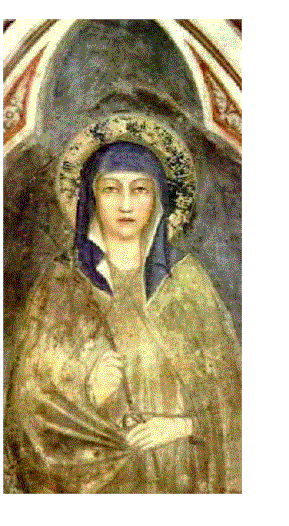SAINT CLARE OF ASSISI


Clare was born into a noble family in the year 1194. She was the daughter of Favarone di Offreduccio and his wife, Ortolana. Clare’s mother, who had gone to pray in the Cathedral of San Rufino shortly before she was to deliver, heard a voice predicting, "O woman. Fear not, for you will happily give birth to a bright light that will illuminate the world.” The baby was named Clare and was baptized in that very church. It can undoubtedly be stated that a large part of the little girl’s education took place right in the Cathedral of San Rufino. The family atmosphere in which Clare grew up was filled with a great sense of spirituality. Clare’s mother raised her daughters very attentively and was one of the few ladies of Assisi who was fortunate enough to travel to the Holy Land.
On the night after Palm Sunday (March 18, 1212), accompanied by Pacifica di Guelfuccio (who was also the first sister to join the Order), the young woman secretly went to the Porziuncola, where Francis and his friars were waiting for her.
Here, the Saint dressed her in the Franciscan robe, cut her hair to consecrate her to a life of penance and then brought her to the Benedictine sisters of St. Paul in the town of Bastia, Umbra. Here, Clare’s father futilely attempted to convince her to come home. Following Francis’ advice, she then took refuge at the church of San Damiano, which became the motherhouse for all her sisters, who were initially called the Poor Women of San Damiano and then, after her death, became known as the Poor Clares. She lived there for forty-two years and was afflicted almost constantly by illness. She began her religious life surrounded by many of her friends and relatives, including her mother Ortolana and her sisters, Agnes and Beatrice.
In 1215, Francis named her abbess and established the first rule of the Order, which would later spread throughout Europe. Clare did not go unnoticed by the prelates and Cardinal Hugolino, the papal legate, drew up the first rule that was to be followed by the monasteries to come. Later, Clare was also granted the privilege of poverty, through which she renounced all possessions.
In 1243, when the Saracens attacked the Monastery of San Damiano, Clare very courageously drove the army out.
Her strength of character, the sweetness of her soul and the way in which she ruled over her community with utmost charity and wisdom won her the esteem of the popes, who even came to visit her.
The death of St. Francis and the news that several monasteries had started to accept property and income disappointed and alarmed Clare who, although she was getting more and more seriously ill, wanted to preserve poverty forever for her convent. She thus composed a Rule that was quite similar to the one followed by the Friars Minor, and in 1252, it was approved by Cardinal Rainaldo (who would later become Pope Alexander IV).
Just before she died, Innocent IV, who brought her his blessing and gave her a copy of the papal bull confirming her rule, also sanctioned the rule. Clare died the very next day (August 11, 1253) as the pope prayed over her. In fact, instead of reciting the Offices of the Dead for her, the pope wanted to chant the joyous Offices of the Virgins. Clare was buried in the church of St. George until the church named after her was completed. Despite the intention of Innocent IV to canonize her immediately after her death, the bull of canonization was not issued until the fall of 1255, after all the formalities had been completed by Alexander IV.